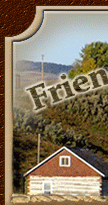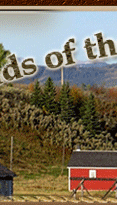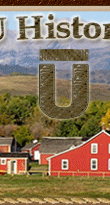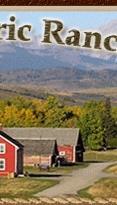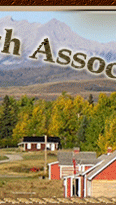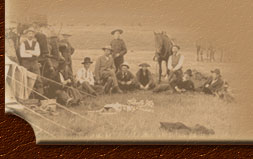| |
|
|
| |
Bar U History
|
|
| |
|
|
 |
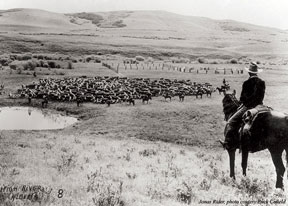 Bar U cattle literally fed the world. The ranch fed workers building the first transcontinental railway and waves of immigrants flooding to a new land. Bar U cattle literally fed the world. The ranch fed workers building the first transcontinental railway and waves of immigrants flooding to a new land.
It fed Canada’s first Indian reservations, the first patrols of Northwest Mounted Police, our nation through the Great Depression and our soldiers through two World Wars. Bar U Percherons, “the work horses that powered North America,” built our cities and roads and pulled our trolleys and fire wagons, from New York City to Victoria, British Columbia.
One of the first, most successful, most enduring large scale cattle ranching operations in Canada, the Bar U in its hay day ranged 30,000 head of cattle on 160,000 acres of grassland, and was world renowned for its stock of 1,000 purebred Percherons.
Located deep in the southern Alberta foothills, on the eastern slopes of the Rocky Mountains, the Bar U, from 1882 to 1950, was a force to be reckoned with. While other large Alberta ranches succeeded for a time only to go out of business, especially after the killer winters of 1886 and 1906, the Mighty Bar U persevered to eventually become a kingpin in a business empire that included a variety of ranches and farming enterprises, as well as meat packing plants and flour mills.
Not only did the Bar U figure prominently in the history of western Canada, it figured prominently in North American and world affairs.
|
 |
| |
|
|
| |
History at a Glance
| |
|
|
| 1881 |
|
Backed by Montreal investors, stockman Frederick Stimson leases 147,000 acres of land to form the North West Cattle Company (NWCC) in March of 1882. Begins branding using Bar U brand. |
| 1883 |
|
Canadian Pacific Railway reaches Calgary, opening new livestock markets in eastern Canada, Great Britain. |
| 1886 |
|
A killer winter wipes out tens of thousands of stock. NWCC suffers fewer losses due to winter feed. |
| 1892 |
|
NWCC expands, purchasing from Canadian government thousands of acres of leased land. |
| 1902 |
|
Former NWCC foreman George Lane forms a partnership to buy the ranch for almost half a million dollars, renaming it the Bar U. |
| 1906 |
|
Another killer winter decimates stock, causing other large cattle ranches to go under. Bar U survives despite losing 16,000 head. |
| 1908 |
|
Lane buys out partners to own the Bar U outright. |
| 1909 |
|
Lane starts world class Percheron breeding operation after importing stud and brood mare stock from Le Perche, France. Takes every prize at show horse competition at Seattle World’s Fair. |
| 1912 |
|
Lane and other ranchmen making up “The Big Four” finance the first Calgary Stampede. Frederick Stimpson dies in Montreal. |
| 1919 |
|
Edward Prince of Wales visits the Bar U, buys neighbouring ranch naming it the EP. |
| 1921 |
|
Cattle and wheat prices fall, Percheron market begins to fails. Lane liquidates assets to keep afloat, his health failing. |
| 1925 |
|
George lane dies. Tributes pour in from far and wide as a bank takes over Lane’s heavily mortgaged properties. |
| 1927 |
|
Ranching and meat packing magnate Patrick Burns purchases the Bar U, cuts operations to survive the depression. |
| 1937 |
|
Another severe winter. Bar U feeds 5,000 head of cattle 38 tons of hay and 500 bushels of oats per day. Survives with relatively few losses. |
| 1937 |
|
Patrick Burns dies. Nephew John Burns takes over the Burns ranching and meatpacking empire. Bar U continues operation as a premiere Burns ranch. |
| 1948 |
|
The Bar U’s final cattle drive. Eleven riders trail almost two thousand head to Burns feedlots in Calgary, taking five and half days. |
| 1950 |
|
Bar U properties are split up and sold. Over the following years, a succession of owners range cattle on small parcels of original Bar U land. |
| 1991 |
|
Parks Canada acquires 367 acres comprising the original ranch headquarters to commemorate ranching history in Canada. |
| 1995 |
|
A National Historic Site of Canada, the Bar U visitor centre opens its doors to the public. |
|
|
| |
|
|
| |
Bar U Who’s Who
|
|
| |
|
|
| |
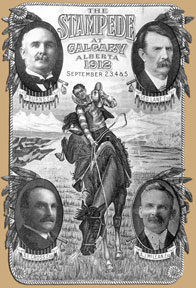 Cowboys, outlaws, royalty, Indians, artists and tycoon businessmen all played roles in the unique story of the “Mighty Bar U”, making it one of the most legendary ranches in Canadian history. Cowboys, outlaws, royalty, Indians, artists and tycoon businessmen all played roles in the unique story of the “Mighty Bar U”, making it one of the most legendary ranches in Canadian history.
Any story about the Bar U Ranch is less a story about land and cattle than it is a story about people. From riders, chore men and chuckwagon cooks to visionary ranch owners, it was the people who visited, lived and worked here who made the Bar U the stuff of legend.
Among some of the more notable people to pass through the ranch gates were:
“Black Jack” John Ware, a former South Carolina slave who gained the respect of his peers when single-handedly saving a herd of Bar U cattle from the ravages of a fierce winter storm.
George Lane, a savvy Montana cowboy who became a respected foreman of the ranch before buying it and transforming it into a piece of world history.
Edward, Prince of Wales, so taken with the Bar U when visiting George Lane, that he bought the ranch next door.
Bar U horse breaker Harry Longabaugh, a Wyoming cowboy whose dollar a day wages weren’t enough and turned to a more lucrative career with his sidekick Butch Cassidy as “The Sundance Kid.”
Everett Johnson, a Bar U cowboy reputed to be the character study for “The Virginian” in the famous American novel and television series of the same name.
American western artist Charlie Russell who, when learning of Bar U owner George Lane’s shooting a pack of attacking wolves from his horse, arrived at the ranch to create a series of now famous oil paintings.
Flamboyant American promoter Guy Weadick, who in 1912 persuaded Bar U owners to finance the first ever “greatest outdoor show on earth” Calgary Stampede, a large scale rodeo now renowned the world over. |
|
| |
|
|
| |
Preserving the Past
|
|
| |
|
|
| |
 To understand where we are going we must first understand where we have come from: our future is inextricably linked to our past. To understand where we are going we must first understand where we have come from: our future is inextricably linked to our past.
Historically, the Bar U was where cowboys learned to be cowboys. Greenhorns learned to rope and ride, bulldog and brand, and if they didn’t, they were soon sent packing. More than a few went on to become successful ranchers in their own right, making the Bar U an important school in the subject of ranching. It still is.
Aided by the Friends of the Bar U Historic Ranch Association, Parks Canada acquired the original Bar U Ranch headquarters, including 367 acres of land, in 1991. Four years later a visitor centre was completed and the site officially opened to the public in 1995.
Comprised of thirty classification one heritage buildings, the Bar U now offers visitors a unique opportunity to see, hear, touch, feel and smell living history. Living, because while the ranch dates back more than 125 years, and cowboy spirits still roam here, the site offers guests an authentic, hands-on, sensory experience. Here you are able not only to learn but experience history. | |
| |
|
|
| |
|
|
|
